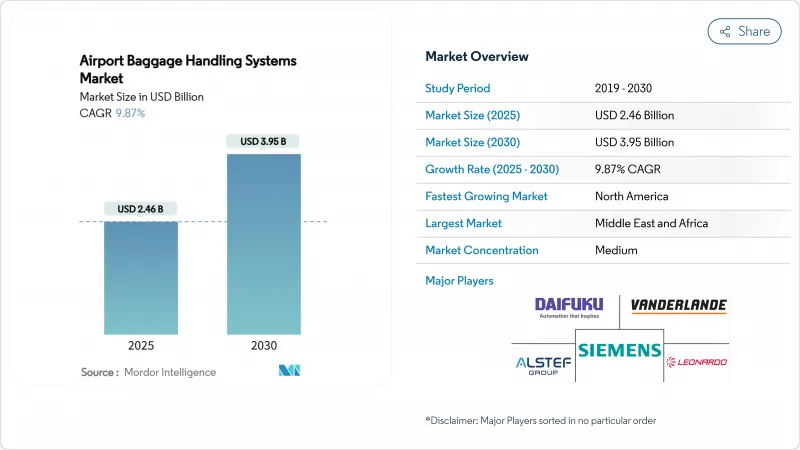
|
市場調査レポート
商品コード
1851397
空港手荷物ハンドリングシステム:市場シェア分析、産業動向、統計、成長予測(2025年~2030年)Airport Baggage Handling Systems - Market Share Analysis, Industry Trends & Statistics, Growth Forecasts (2025 - 2030) |
||||||
カスタマイズ可能
適宜更新あり
|
|||||||
| 空港手荷物ハンドリングシステム:市場シェア分析、産業動向、統計、成長予測(2025年~2030年) |
|
出版日: 2025年07月03日
発行: Mordor Intelligence
ページ情報: 英文 120 Pages
納期: 2~3営業日
|
概要
空港手荷物ハンドリングシステム市場の2025年の市場規模は24億6,000万米ドルで、2030年には39億5,000万米ドルに達すると予測され、CAGRは9.87%と堅調に推移します。

成長は、航空セクターの旅客数回復、着実な容量拡張のパイプライン、労働力不足とセキュリティ・コンプライアンス・コストの上昇を回避するための空港の自動化へのシフトに支えられています。中期的なシステム改修、デジタル・ツインによる予知保全、コンピュータ・ビジョンに基づく追跡は、空港手荷物ハンドリングシステム市場のあらゆる階層で調達の優先順位を変えています。また、規制当局がインシデント報告期限を厳格化したことで、サイバーセキュリティへの対応はバックオフィスの関心事から取締役会レベルの調達基準へと移行しています。資本プロジェクトでは、持続可能性目標や公衆衛生ガイドラインを満たすために、ハイブリッドシステム、エネルギー効率の高いモーター、UV-C消毒モジュールをバンドルするケースが増えています。
世界の空港手荷物ハンドリングシステム市場の動向と洞察
急増する世界の旅客数
空港手荷物ハンドリングシステム市場を独占するハブ空港の手荷物インフラに深刻な負担を強いています。国際空港評議会(Airports Council International)は、2040年までに旅客数が倍増すると予測しており、この見通しが機器の交換サイクルを加速させ、拡張可能なモジュール式レイアウトへの関心を高めています。4,000万人以上の旅行者を処理するメガハブ空港では、ピーク時の処理能力を維持するため、早期手荷物保管モジュールやトートベースのソーターを増設しています。手荷物の誤処理は2023年には乗客1,000人あたり6.9件に減少するもの、誤ルーティングされた手荷物1つにつき、航空会社は依然として100~200米ドルの補償金と再ルート手数料を負担しており、空港はAIを活用した根本原因分析への投資を進めています。北米の事業者は、今後5年間でパンデミック前の75%のアップグレード予算を計上しており、空港手荷物ハンドリングシステム市場の長期的な需要底上げを強調しています。
空港容量拡大プログラム
年間2億6,000万人の旅客を想定して設計された350億米ドルのアル・マクトゥーム国際空港拡張計画などの画期的なプロジェクトは、次世代手荷物システムが指定される規模の大きさを示しています。スキポール空港の60億ユーロ(81億3,000万米ドル)のプログラムでは、人間工学に基づいた作業環境を改善するための空調設備のアップグレードを組み込みながら、手荷物地下室の近代化を図っています。ソルトレイクシティからシアトル・タコマに至る北米の空港では、LEEDに適合したモーター技術を新しい路線に組み込むことで、軽負荷時の電力消費を最大25%抑制しています。このようなプロジェクトは、空港手荷物ハンドリングシステム市場において、後付けセンサー、制御ソフトウェアライセンス、サイバーセキュリティ監査のためのロングテールのアフターマーケット収益の流れを生み出しています。
高い設備投資と長いROIサイクル
包括的な手荷物プロジェクトは、当初予算を上回るのが常です。シアトル・タコマ空港の最適化は、試運転前に3億2,000万米ドルから5億4,000万米ドルに跳ね上がりました。10~15年という長い投資回収期間は、民営化されたターミナルのコンセッション期間と衝突するため、運営会社は利用料収入を確保するか、グリーンボンドを活用せざるを得ないです。国際空港評議会は現在、財務委員会に対して、ソブリン利回りを150ベーシス・ポイント上回るハードル・レートでROIをストレステストすることを推奨しているが、それでも小規模な事業者は、債務返済のカバレッジが難しいことに気づいています。
セグメント分析
年間旅行者数が4,000万人を超える旅客ハブ空港は、2024年の空港手荷物ハンドリングシステム市場シェアの40.31%を占める。これらのメガ施設はCAGR 10.41%を記録し、2025-2030年の空港手荷物ハンドリングシステム市場規模の成長曲線を支えています。これらの空港の予算は、小規模空港が2回の技術サイクルを経て初めて採用することが多い、個々の航空会社システム、ロボット工学、AI対応制御スイートをサポートしています。ドバイのアル・マクトゥームの青写真は、組み込み型スマート・コンベヤと予知保全ダッシュボードがデジタルツインのマスタープランとどのように統合され、将来的な需要急増に対応しているかを示しています。
2,500万人から4,000万人規模の中堅空港では、ピーク時の荷物の重圧を和らげる早期手荷物保管ゾーンから段階的にアップグレードすることで、技術革新のギャップを縮めています。旅客数1,500万人から2,500万人の施設は、地下を全面的に改築することなく精度を上げるため、モジュール式コンベアとRFIDゲートウェイを標準化しています。旅客数1,500万人以下の小規模空港は、設備投資を抑え、自動化フットプリントを徐々に拡大するため、共用セルフサービス機器に傾注しています。ベンダーの価格設定が下がるにつれ、以前はメガハブ空港に限定されていたテクノロジーが下流に流れ込み、すべての空港手荷物ハンドリングシステム市場ノードで基本的な期待が高まる。
チェックイン・チケッティングソリューションは、2024年の空港手荷物ハンドリングシステム市場の31.56%を占め、あらゆるターミナル入口段階でのユビキタス性を反映しています。しかし、トラッキング&トレーシングソリューションは11.20%のCAGRで推移しており、トランザクションの自動化からデータ中心の意思決定支援へと経営陣が軸足を移していることを裏付けています。航空会社は、エンド・ツー・エンドの可視化が標準的な慣行となれば、旅客1人当たり最大3米ドルの誤処理コスト削減を定量化し、空港がRFIDマットを受け取りベルトや引き渡しポイントの下に埋め込む動機付けとなります。
規制当局が検知基準を改訂する場合でも、セキュリティ検査モジュールは調達の優先課題として残ります。TSAだけでも、コンベアロジックや監視制御ソフトウェアとシームレスに連携する必要がある次世代爆発物検知器に年間2億5,000万米ドルを割り当てています。初期の手荷物保管プラットフォームは、数時間前に手荷物を受け取る柔軟性を航空会社に提供することで、滞留時間を収益化します。収束効果により、空港手荷物ハンドリングシステムの市場規模は、単に旅客数の増加だけでなく、複数の収益レバーにわたって拡大し続けています。
空港手荷物ハンドリングシステムレポートは、空港容量(1,500万人まで、1,500万人から2,500万人まで、2,500万人から4,000万人まで、4,000万人以上)、ソリューション(チェックイン・発券システム、セキュリティ検査システム、その他)、技術(バーコード、RFID、その他)、システムタイプ(ベルトコンベアシステム、その他)、地域(北米、欧州、その他)で区分されています。市場予測は金額(米ドル)で提供されます。
地域分析
北米が32.22%のシェアを占め、空港手荷物ハンドリングシステム市場の首位を維持しています。TSAの年間2億5,000万米ドルのスクリーニングアップグレードプログラムなどの近代化指令がコンベヤメーカーの受注を支えています。しかし、レガシー・インフラストラクチャは、業務を中断することなく混雑した地下室にレトロフィットを挿入する必要があり、設置スケジュールや統合費用を引き上げるため、拡張を複雑にしています。カナダとメキシコは増加成長を供給しているが、ハブ・アンド・スポーク・ネットワークの優位性と持続可能性に関する法律の成熟により、米国が支柱であり続けています。
中東・アフリカは、欧州の多くの国の合計を上回る旅客処理能力を目標とする中東湾岸のメガプロジェクトに後押しされ、CAGR最速の11.15%を記録しました。ドバイのアル・マクトゥーム拡張は、地域のプランナーが中間技術ステップを回避し、ロボット工学、AIダッシュボード、タッチフリー消毒モジュールを第一段階の建設に導入したことを示しています。ケープタウンのようなアフリカのゲートウェイでは、10億米ドルを超える近代化予算が組まれているが、資金調達のサイクルによって実施時期がずれる可能性があります。貨物量の大幅な増加は、より統合された手荷物と貨物のハンドリングソリューションにもつながり、空港手荷物ハンドリングシステム市場のフットプリントは、純粋な旅客アプリケーション以外にも広がっています。
欧州とアジア太平洋は、ブラウンフィールドの制約が厳しい炭素目標に適合するテクノロジーの先陣を切っています。スキポール空港の60億ユーロ(70億7,000万米ドル)計画では、人間工学に基づいた作業スペースと、熱によるモーターの故障を最小限に抑える気候的に安定したコンベアホールを提供するため、手荷物地下室全体を再構築しています。ハイデラバードからジャカルタまでのアジアのハブは、グローバル・サプライヤーの製造拠点として機能しています。ダイフクのインドの新工場は、生産能力を4倍に拡大し、地域の顧客のリードタイムを短縮しています。南米では、航空会社がネットワークを再構築し、空港がマルチラテラル・バンク・ファイナンスを活用してグリーンフィールドのアップグレードのリスクを軽減しているため、絶対的な投資額はまだ少ないもの、追い上げの勢いを見せています。
その他の特典:
- エクセル形式の市場予測(ME)シート
- 3ヶ月間のアナリストサポート
よくあるご質問
目次
第1章 イントロダクション
- 調査の前提条件と市場の定義
- 調査範囲
第2章 調査手法
第3章 エグゼクティブサマリー
第4章 市場情勢
- 市場概要
- 市場促進要因
- 世界の旅客数の急増
- 空港容量拡大プログラム
- 統合型RFIDトラッキングへのシフト
- エンド・ツー・エンドの自動化需要
- 収益源としての早期手荷物預かり(EBS)
- パンデミック(世界的大流行)による消毒設備の改修
- 市場抑制要因
- 高い設備投資と長いROIサイクル
- レガシーITと相互運用性のギャップ
- 空港労働組合の自動化への反発
- サイバーセキュリティ対応コスト(EU NIS2/FAA AD)
- バリューチェーン分析
- 規制情勢
- テクノロジーの展望
- ポーターのファイブフォース分析
- 新規参入業者の脅威
- 買い手の交渉力/消費者
- 供給企業の交渉力
- 代替品の脅威
- 競争企業間の敵対関係
第5章 市場規模と成長予測
- 空港容量別
- 最大1,500万人
- 1,500万~2,500万
- 2,500万~4,000万
- 4,000万人以上
- ソリューション別
- チェックインおよび発券システム
- セキュリティ・スクリーニング・システム
- 搬送・仕分けシステム
- 初期手荷物保管
- 手荷物の引き取り/積み下ろし
- 追跡とトレース
- 技術別
- バーコード
- RFID
- IoTセンサーとエッジ・デバイス
- ロボット工学と自律走行車
- AI/機械学習ソフトウェア
- システムタイプ別
- コンベヤベルトシステム
- チルトトレイおよびクロスベルトソーター
- 目的地コード付き車両(DCV)
- トートベース/個別キャリアシステム
- ハイブリッドおよびその他の新興システム
- 地域別
- 北米
- 米国
- カナダ
- メキシコ
- 欧州
- 英国
- フランス
- ドイツ
- その他欧州地域
- アジア太平洋地域
- 中国
- インド
- 日本
- 韓国
- その他アジア太平洋地域
- 南米
- ブラジル
- アルゼンチン
- その他南米
- 中東・アフリカ
- 中東
- サウジアラビア
- アラブ首長国連邦
- その他中東
- アフリカ
- 南アフリカ
- エジプト
- その他アフリカ
- 北米
第6章 競合情勢
- 市場集中度
- 戦略的動向
- 市場シェア分析
- 企業プロファイル
- Daifuku Co. Ltd.
- Vanderlande Industries BV
- Siemens AG
- BEUMER Group
- Alstef Group
- CIMC TianDa Holdings Co. Ltd.
- SITA N.V.
- Ansir Systems
- G&S Airport Conveyer
- Leonardo S.p.A
- Pteris Global Limited
- RBS Global Media Ltd.
- Amadeus IT Group, S.A.
- Lyngsoe Systems A/S
- Brock Solutions
- FIVES SAS
- Robson Handling Technology Ltd.
- ULMA Group

